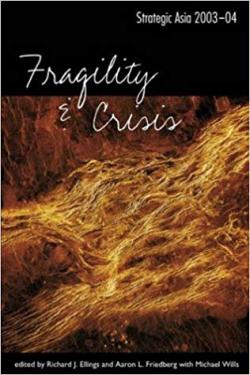Strategic Asia: Fragility and Crisis

By Aaron Friedberg, Richard Ellings, et. al.
The National Bureau of Asian Research (September 1, 2003)
ISBN-13: 978-0971393837
Review by Tomohiko Taniguchi
"So you follow 'Strategic Asia' keenly, don't you?" A Chinese political scientist asked me when I was staying at the Shanghai Institute for International Studies as a visiting fellow in the early part of 2003.
Strategic Asia is an initiative, largely web-based, run by the US National Bureau of Asian Research (NBR) in order to focus upon and summarise annually what they view as Asian developments deserving scrutiny from the US strategic viewpoint. Readers of this review are strongly encouraged themselves to view the NBR website at http://www.nbr.org/. The wide-ranging analyses published annually cover the entire region, with special emphasis placed upon major powers, including the US, Russia, Japan and India, but most importantly, China.
The Chinese scholar unintentionally revealed, by asking me this question, how keenly they are following the discussions NBR presents at the web site. It may well be that the web-based discussions have the single largest audience in China, not necessarily due only to demographic reasons.
Whatever is said in public, not a small number of US strategic thinkers think, at the bottom of their hearts, of China as aspiring for a hegemonic status in East Asia, possibly with the ultimate goal of driving US influences out of the region. I suspect that the Chinese know this, as this is indeed their aim. And in almost no other place could they be exposed to such straightforward views on China expressed by US strategic thinkers as are available at the NBR website.
NBR publishes its annual report, also entitled Strategic Asia, and the newest 2003-2004 version with the subtitle "Fragility and Crisis" is now available in print. As previously, the volume is co-edited by Aaron L. Friedberg, a Princeton professor-cum-Chief of Staff to US Vice President Dick Cheney, whose views on China are important in two aspects:
Firstly, his views are shared by an important group of US strategic thinkers, most notably the Vice President and the "wise man" at the Pentagon, Andy Marshall, with whom Dr. Friedberg has collaborated in shaping US military strategies for future warfare;
Secondly, his represent one of the quintessential realist views that the US leaders have traditionally held, that is to say, the US will never allow a hostile power to emerge and dominate on either front of the Eurasian land mass.
It should also be noted that it was Friedberg who was most instrumental when a group of experts under the spiritual guidance of Andy Marshall conducted scenario writing sessions a few years ago, culminating in the oft-cited Pentagon paper "Asia 2025".
The annual report hence makes a must read for anyone wishing to be accustomed to the line of thought US strategists hold in regard to Strategic Asia. If the US-Japan alliance is a function to how the US regards much broader Strategic Asia, the report should also be read to better foresee how the bilateral relations will henceforth evolve.
More benefits of reading Strategic Asia are as follows:
It is a handy one-stop summary of what has happened in the preceding year in Strategic Asia, or more precisely, what US strategists think has happened in the region. Special emphasis is given, relative to the importance of the day, to particular regions. For instance the chapter dealing with Central Asia is full of knowledge that is hard for a non-expert to compile. Its 2002-03 version also contains a special study on "Islam and Asian Security", to take another example.
Its supplementary part "Strategic Asia by the Numbers" also includes some useful figures and statistics readers can take as elements deemed important from US strategic point of view. The statistics listed are mainly on trade relationships and military balances among the nations in question, and thus are hard to find elsewhere.
Of note in conclusion is that the report came into being through a grant given to the NBR by the US Department of Energy. This is no coincidence as in the US it is the Energy Department, along with the Pentagon, that has a rare commodity inside the Washington beltway - that is long-term views.
This review first appeared on the GLOCOM Platformand is reproduced with permission.

